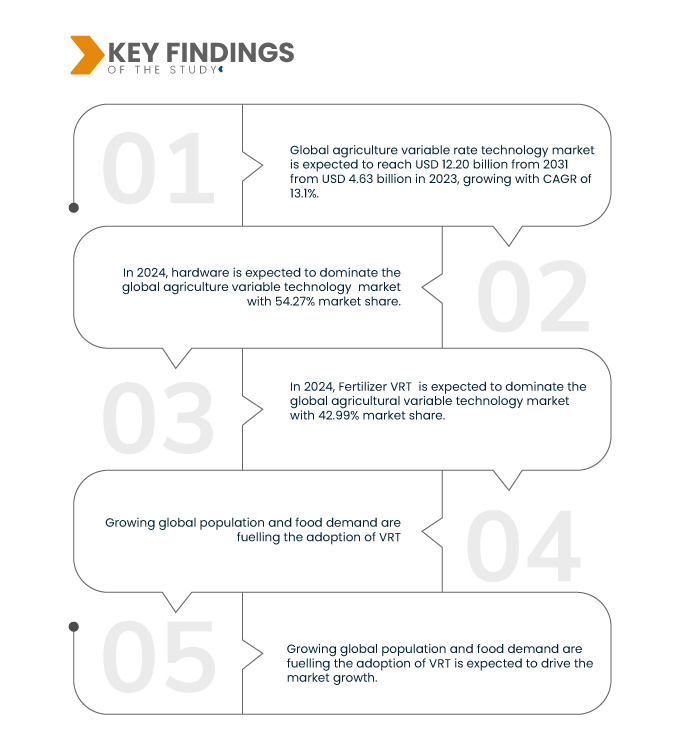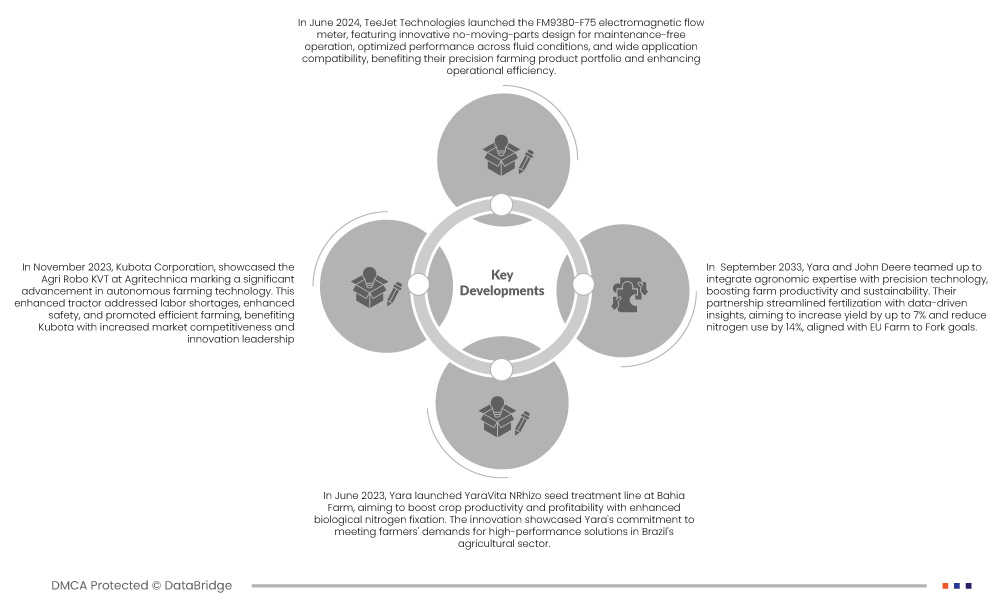The growing global population and increasing food demand are placing unprecedented pressures on agriculture productivity. In response, the adoption of Variable Rate Technology (VRT) is rapidly expanding across the agriculture sector. VRT enables precise application of inputs such as fertilizers, pesticides, and seeds, tailored to specific conditions within a field. This technology optimizes resource utilization, minimizes environmental impact, and enhances crop yields, thereby addressing the dual challenges of feeding a burgeoning population while sustainably managing natural resources. As farmers strive for greater efficiency and sustainability in their operations, VRT emerges as a pivotal tool in modern agriculture, driving innovation and shaping the future of food production worldwide.
Access Full Report @ https://www.databridgemarketresearch.com/ru/reports/global-agricultural-variable-rate-technology-market
Data Bridge Market Research analyzes that the Global Agriculture Variable Rate Technology Market is expected to reach a value of USD 12.20 billion by 2031 from USD 4.63 billion in 2023, growing with CAGR of 13.1% during the forecast period.
Key Findings of the Study
Increase in Usage of Drone in Agriculture Sector
The increasing usage of drones in the agriculture sector is significantly driving the agriculture variable technology market forward. Drones, equipped with advanced imaging technologies such as multispectral and thermal cameras, enable farmers to gather real-time, high-resolution data about their fields. This data allows for precise monitoring of crop health, identification of areas requiring specific treatments like irrigation or pesticide application, and assessment of overall field variability. By integrating drone-collected data with precision agriculture techniques like Variable Rate Technology (VRT), farmers can optimize their resource management strategies, reduce input costs, and improve crop yields. Furthermore, drones offer operational efficiencies by enabling rapid and frequent field surveys, even in large or remote areas, which enhances decision-making and responsiveness to changing field conditions. As a result, the adoption of drones in agriculture not only enhances productivity and sustainability but also drives the growth of the agriculture variable technology market by expanding the application and effectiveness of precision farming practices.
Report Scope and Market Segmentation
|
Report Metric
|
Details
|
|
Forecast Period
|
2024 to 2031
|
|
Base Year
|
2023
|
|
Historic Years
|
2022 (Customizable to 2016-2021)
|
|
Quantitative Units
|
Revenue in USD Billion
|
|
Segments Covered
|
Offering (Hardware, Software, and Services), Application (Fertilizer VRT, Seeding VRT, Crop Protection Chemical VRT, Irrigation VRT, Yield Monitoring, and Others), Type (Map-Based VRT and Sensor Based VRT), Farm Size (Large Farm, Mid-Sized Farm, and Small Farm) Crop Type (Cereals & Grains, Fruits & Vegetables, Oilseed & Pulses, and Others)
|
|
Countries Covered
|
U.S., Canada, Italy, France, Germany, Spain, Poland, Netherlands, Romania, Denmark, Belgium, Greece, Hungary, Portugal, Ireland, Austria, Czechia, Sweden, Bulgaria, Finland, Croatia, Lithuania, Slovakia, Latvia, Slovenia, Cyprus, Estonia, Luxembourg, Malta and Non-EU Europe, China, Australia, Japan, South Korea, India, New Zealand, Taiwan, Singapore, Malaysia, Thailand, Vietnam, Indonesia, Philippines, and Rest of Asia-Pacific, Brazil, Argentina, Mexico, and Rest of Latin America, Saudi Arabia, South Africa, Egypt, Bahrain, Oman, Israel, Kuwait, Qatar, U.A.E., Rest of Middle East and Africa
|
|
Market Players Covered
|
Deere & Company (U.S.), Trimble Inc. (U.S.), Topcon (Japan), KUBOTA Corporation. (Japan), Yara (Norway), Sensoterra (Netherlands), Lindsay Corporation. (U.S.), Valmont Industries, Inc. (U.S.), Hexagon AB (Sweden), CaroVail, Inc. (U.S.), Raven Industries Inc. (U.S.), Cropin Technology Solution Private Limited (India), AGRIVI (U.K.), Taranis (U.S.), Droned Deploy. (U.S.), EOS Data Analytics,Inc. (U.S.), AgJunction Inc. (U.S.), TeeJet Technologies (U.S.), Falcon Soil Technologies (U.S.), AgReliant Genetics, LLC. (U.S.), VRTSolutions (Australia), 4AgTech LLC. (U.S.), Climate LLC. (A subsidiary of Bayer AG) (U.S.), Crop Quest, Inc. (U.S.), FRONTIER AGRICULTURE LTD (U.K) among others
|
|
Data Points Covered in the Report
|
In addition to the market insights such as market value, growth rate, market segments, geographical coverage, market players, and market scenario, the market report curated by the Data Bridge Market Research team includes in-depth expert analysis, import/export analysis, pricing analysis, production consumption analysis, and pestle analysis.
|
Segment Analysis
The global agriculture variable technology market is segmented into five notable segments, which are based on the basis offering, application, type, farm size, and crop type.
- On the basis of offering, the global agriculture variable technology market is segmented into hardware, software, and services
In 2024, hardware is expected to dominate the global agriculture variable technology market
In 2024, hardware is expected to dominate the market with 54.35% market share due to growing global population and food demand are fuelling the adoption of VRT.
- On the basis of application, the global agriculture variable technology market is segmented into fertilizer VRT, seeding VRT, crop protection chemical VRT, irrigation VRT, yield monitoring, and others
In 2024, fertilizer VRT is expected to dominate the global agriculture variable technology market
In 2024, fertilizer VRT is expected to dominate the market with 42.99% market share because increase in usage of drone in agriculture sector.
- On the basis of type, the global agriculture variable technology market is segmented into map-based VRT and sensor based VRT. In 2024, map-based VRT is expected to dominate the market with 61.26% market share
- On the basis of farm size, the global agriculture variable technology market is segmented into large farm, mid-size farm, and small farm. In 2024, large farm is expected to dominate the market with 52.17% market share in the forecast period of 2024 to 2031
- On the basis of crop type, the global agriculture variable technology market is segmented into cereals & grains, fruits & vegetables, oilseed & pulses, and others. In 2024, the Cereals & Grains segment is expected to dominate the market with 38.19% market share
Major Players
Data Bridge Market Research analyzes KUBOTA CORPORATION (Japan), Deere & Company (U.S.), FRONTIER AGRICULTURE LTD. (U.K.), Valmont Industries (U.S.), Hexagon AB (Sweden) as major market players in this market.
Market Development
- In June 2024, TeeJet Technologies launched the FM9380-F75 electromagnetic flow meter, featuring innovative no-moving-parts design for maintenance-free operation, optimized performance across fluid conditions, and wide application compatibility, benefiting their precision farming product portfolio and enhancing operational efficiency
- In November 2023, Kubota Corporation, showcased the Agri Robo KVT at Agritechnica marking a significant advancement in autonomous farming technology. This enhanced tractor addressed labor shortages, enhanced safety, and promoted efficient farming, benefiting Kubota with increased market competitiveness and innovation leadership
- In September 2023, Yara and John Deere teamed up to integrate agronomic expertise with precision technology, boosting farm productivity and sustainability. Their partnership streamlined fertilization with data-driven insights, aiming to increase yield by up to 7% and reduce nitrogen use by 14%, aligned with EU Farm to Fork goals
Regional Analysis
Geographically, the countries covered in the global agriculture variable technology market report are U.S., Canada, Italy, France, Germany, Spain, Poland, Netherlands, Romania, Denmark, Belgium, Greece, Hungary, Portugal, Ireland, Austria, Czechia, Sweden, Bulgaria, Finland, Croatia, Lithuania, Slovakia, Latvia, Slovenia, Cyprus, Estonia, Luxembourg, Malta and Non-EU Europe, China, Australia, Japan, South Korea, India, New Zealand, Taiwan, Singapore, Malaysia, Thailand, Vietnam, Indonesia, Philippines, and Rest of Asia-Pacific, Brazil, Argentina, Mexico, and rest of Latin America, Saudi Arabia, South Africa, Egypt, Bahrain, Oman, Israel, Kuwait, Qatar, U.A.E., and rest of Middle East and Africa.
As per Data Bridge Market Research analysis:
North America is expected to dominate region in the global agriculture variable technology market
North America is dominating the agriculture variable technology market its larger market capitalization, well-structured regulation, and higher total number of futures for innovative technology.
Asia-Pacific is expected to be the fastest region in the global agriculture variable technology market
Asia-Pacific is expected to be a fastest growing region in agriculture variable technology market due to improvement in the quantity and quality of yield and labor cost reduction.
For more detailed information about global agriculture variable technology market, click here – https://www.databridgemarketresearch.com/ru/reports/global-agricultural-variable-rate-technology-market















